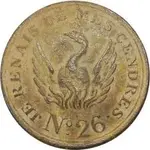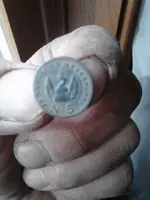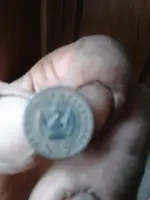You are using an out of date browser. It may not display this or other websites correctly.
You should upgrade or use an alternative browser.
You should upgrade or use an alternative browser.
found a military button today it says je renais de mes cendres any info wouldbe great
- Thread starter jpd
- Start date
- #3
Thread Owner
Now thats a great find!!!!!!
Thank u I was excited
CRUSADER
Emerald Member
Thank u I was excited
Anyone who likes buttons & history would be!
coiny
Jr. Member
I think that means "I will be reborn from my ashes". I may have the wrong verb tense. It's been a long time since I studied French.
John Boy
Bronze Member
- Joined
- Sep 11, 2012
- Messages
- 1,216
- Reaction score
- 304
- Golden Thread
- 0
- Detector(s) used
- FISHER F75 LTD CAMOUFLAGE,CZ3D 1021,1220X AND GARRETT PRO POINTER.
- Primary Interest:
- All Treasure Hunting
It seems to be fairly rare and to think the distance it traveld I found it in mass and it started in haiti looking on old maps now to see if the house belonged to a captain maybe or other kind of vet
I was wondering where it came from. That's cool.yeah I'd be checking it out to.could also been a relative.keep us posted if ya find out anything.
Deepdiger60
Silver Member
- Joined
- Jun 18, 2009
- Messages
- 2,804
- Reaction score
- 97
- Golden Thread
- 0
- Location
- Long Island E-end
- Detector(s) used
- Minelab Sov GT,Sovereign xs2-pro Fisher CZ21 Custom Skullies , Stealth 720-i
- Primary Interest:
- All Treasure Hunting
Great find JPD  that is a rare button for sure the 5 varity i have some infro on it the one below is described as a dug button it might help your search that should be up on the Banner !! Jim
that is a rare button for sure the 5 varity i have some infro on it the one below is described as a dug button it might help your search that should be up on the Banner !! Jim 
(ca. 1832-33) Oregon Territory Phoenix button. Brass. Rulau-E Ore 5 var. Very Fine. 70.1gns. 24.2mm. Shank attached on the reverse. The obverse features a phoenix rising from flames with JE RENAIS DE MES CENDRES (which translates to “I rise from my ashes") around and the regimental designation No. 1 below. Rulau lists the type as Rarity-5. Rough surfaces with a rust colored patina. Sharp details remain, sharper than the example in our March 2010 sale (Lot 1), but not as smooth, undoubtedly a ground find.
****INTRO*****Stack’s is pleased to present to the collecting community this select grouping of Oregon Phoenix Buttons. Produced in England for use by Haiti's King Henri Christophe before 1820, according to Rulau, quantities of these buttons were imported into the Pacific Northwest circa 1832-33, likely by a trader named Nathaniel Wyeth. Their frequent appearance in Western archaeological contexts has led them to be collected as Indian trade goods and as tokens, thus their listing in the Rulau token reference. Rulau notes "the buttons are found most extensively on Sauvies Island, along the Cowlitz and Clackamas Rivers, at the falls at Oregon City, and at the Cascades. They have also been found near California missions at San Juan Capistrano, San Luis Rey, Santa Barbara, and Santa Ynez."
This grouping was consigned to us by a family whose roots in Oregon extend to 1852 and includes three major types: Rulau-E Ore 5 var, Rulau-E Ore 6 var, and Rulau-E Ore 7 var. Rulau lists the different regimental numbers as a different listing, but since some of the regimental numbers are not listed in his reference, we are calling them a variety of the main listings. He notes that there are, "In all, some 600 of these buttons of all types known."

(ca. 1832-33) Oregon Territory Phoenix button. Brass. Rulau-E Ore 5 var. Very Fine. 70.1gns. 24.2mm. Shank attached on the reverse. The obverse features a phoenix rising from flames with JE RENAIS DE MES CENDRES (which translates to “I rise from my ashes") around and the regimental designation No. 1 below. Rulau lists the type as Rarity-5. Rough surfaces with a rust colored patina. Sharp details remain, sharper than the example in our March 2010 sale (Lot 1), but not as smooth, undoubtedly a ground find.
****INTRO*****Stack’s is pleased to present to the collecting community this select grouping of Oregon Phoenix Buttons. Produced in England for use by Haiti's King Henri Christophe before 1820, according to Rulau, quantities of these buttons were imported into the Pacific Northwest circa 1832-33, likely by a trader named Nathaniel Wyeth. Their frequent appearance in Western archaeological contexts has led them to be collected as Indian trade goods and as tokens, thus their listing in the Rulau token reference. Rulau notes "the buttons are found most extensively on Sauvies Island, along the Cowlitz and Clackamas Rivers, at the falls at Oregon City, and at the Cascades. They have also been found near California missions at San Juan Capistrano, San Luis Rey, Santa Barbara, and Santa Ynez."
This grouping was consigned to us by a family whose roots in Oregon extend to 1852 and includes three major types: Rulau-E Ore 5 var, Rulau-E Ore 6 var, and Rulau-E Ore 7 var. Rulau lists the different regimental numbers as a different listing, but since some of the regimental numbers are not listed in his reference, we are calling them a variety of the main listings. He notes that there are, "In all, some 600 of these buttons of all types known."
Last edited:
John_Deere
Hero Member
- Joined
- Mar 7, 2013
- Messages
- 600
- Reaction score
- 193
- Golden Thread
- 0
- Location
- Fredericksburg
- Detector(s) used
- Personal: Bounty Hunter Gold Digger
Family: White's Coinmaster
- Primary Interest:
- All Treasure Hunting
Definitely French, but I don't know much of that, even though I'm in French 3 right now! Shows how much of it has stuck . Congrats and HH!
. Congrats and HH!
 . Congrats and HH!
. Congrats and HH!Tom_in_CA
Gold Member
- Joined
- Mar 23, 2007
- Messages
- 13,803
- Reaction score
- 10,339
- Golden Thread
- 2
- Location
- Salinas, CA
- 🥇 Banner finds
- 2
- Detector(s) used
- Explorer II, Compass 77b, Tesoro shadow X2
ha, thanx for the into kuger. JPD, nice find. Thanx for posting. Those are not found too often back east. They're most often found on the west coast (CA, OR, and WA). They've taken on a sort of "metal detecting lore" amongst hunters here, d/t their known arrival time of late 1810's-ish (or maybe early 1820s). So whenever they turn up, you can know there's potential for reales, etc... Some have even been known to fetch a few hundred dollars, but lately, the market seems to be back-down.
The reason there's a market for them (at least the market I've seen, in most of the ones I've sold), is they were popularized by a book that came out in the mid 1960s: Stone Age on the Columbia River. That book dealt with indian history of the Columbia river area, yet had a chapter dedicated to contact era indian trade goods. Mind you, indian artifact hunting had gone on in the area, since as early as the turn-of-the-century (not unlike indian artifact buffs, even to this day in various regions). Well that chapter was popular amongst diggers and relic hunters of that period (1960s/70s), because there were already persons in the area, who had handfuls of them from the decades leading up to them (people sifting for them, etc...). As soon as the history of this particular button got a good-writeup of history, buffs in the area took it as sort of a 'bingo game' of sorts, to get all the different #s, sizes, and so forth. So to this day, there are still indian artifact buffs there, who sometimes bid them up. Also anyone who's into the history of the former French colony of Haiti (where these buttons were meant to outfit the army that was to have put down a rebellion there) have been known to bid on them. Apparently this was no small episode in European colonial history of the new world, specifically this colony of France.
Anyhow, in the interest of space, (so I don't get writer's cramp), do this: go the main page of T'net. You will see a tab "advanced search". Once there, do a search on phoenix button with quotes around it ("phoenix button"). Choose the option of "any date". Then you will get hits going way-back-to-whenever on T'net, where this subject has come up. You can see where else they've been found, and you can see more detailed writeups I, and others, have given on them.
If you don't mind, I'm forwarding this link to a certain collector/author in the Pac. Northwest. He is working on new book on indian trade artifacts. He's keeping a mental picture on their distribution back east (ie.; what other states they're found in), as possible clues to their arrival and subsequent distribution in the USA.
The reason there's a market for them (at least the market I've seen, in most of the ones I've sold), is they were popularized by a book that came out in the mid 1960s: Stone Age on the Columbia River. That book dealt with indian history of the Columbia river area, yet had a chapter dedicated to contact era indian trade goods. Mind you, indian artifact hunting had gone on in the area, since as early as the turn-of-the-century (not unlike indian artifact buffs, even to this day in various regions). Well that chapter was popular amongst diggers and relic hunters of that period (1960s/70s), because there were already persons in the area, who had handfuls of them from the decades leading up to them (people sifting for them, etc...). As soon as the history of this particular button got a good-writeup of history, buffs in the area took it as sort of a 'bingo game' of sorts, to get all the different #s, sizes, and so forth. So to this day, there are still indian artifact buffs there, who sometimes bid them up. Also anyone who's into the history of the former French colony of Haiti (where these buttons were meant to outfit the army that was to have put down a rebellion there) have been known to bid on them. Apparently this was no small episode in European colonial history of the new world, specifically this colony of France.
Anyhow, in the interest of space, (so I don't get writer's cramp), do this: go the main page of T'net. You will see a tab "advanced search". Once there, do a search on phoenix button with quotes around it ("phoenix button"). Choose the option of "any date". Then you will get hits going way-back-to-whenever on T'net, where this subject has come up. You can see where else they've been found, and you can see more detailed writeups I, and others, have given on them.
If you don't mind, I'm forwarding this link to a certain collector/author in the Pac. Northwest. He is working on new book on indian trade artifacts. He's keeping a mental picture on their distribution back east (ie.; what other states they're found in), as possible clues to their arrival and subsequent distribution in the USA.
- Joined
- Jan 27, 2009
- Messages
- 18,879
- Reaction score
- 12,145
- Golden Thread
- 1
- Location
- South East Tennessee on Ga, Ala line
- 🥇 Banner finds
- 1
- Detector(s) used
- Tesoro Conquistador freq shift
Fisher F75
Garrett AT-Pro
Garet carrot
Neodymium magnets
5' Probe
- Primary Interest:
- All Treasure Hunting
Great find and interesting history attached. It amazes me the collective wealth of knowledge on here sometimes. Nice French button.
Similar threads
- Replies
- 13
- Views
- 985
- Replies
- 10
- Views
- 734
- Replies
- 7
- Views
- 529
Users who are viewing this thread
Total: 1 (members: 0, guests: 1)
Latest Discussions
-
-
-
-
Robotics experts from sunny Madeira and vibrant London here!
- Latest: Treasure_Hunter
-
-



